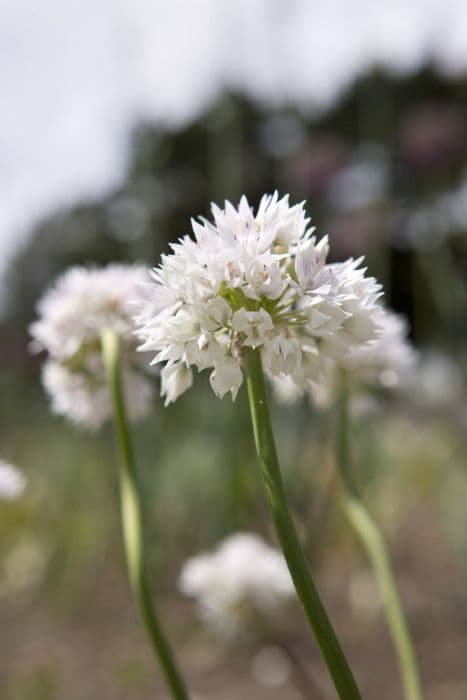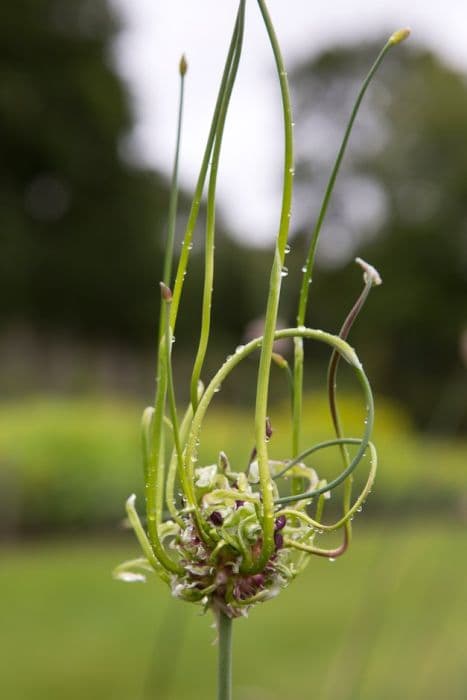Ornamental onion Allium loratum 'Sweet Candy'

ABOUT
The Allium loratum 'Sweet Candy' is characterized by its distinctive spherical flower heads that are comprised of numerous tiny, star-shaped blooms. These flowers often boast a vibrant pink or lilac color which creates a dazzling visual effect when clustered together. Each spherical head appears perched atop a slender, green stem which adds an air of elegance and grace to the plant's overall appearance. The foliage of 'Sweet Candy' typically emerges as linear and strap-shaped leaves, providing a lush green backdrop that contrasts beautifully with the striking flowers. Their leaves give the impression of neatness and order, which complement the dramatic flowering display that usually emerges in the spring or early summer. When in full bloom, the round balls of flowers attract bees, butterflies, and other pollinators, adding a lively energy to the plant's presence. The silhouette of 'Sweet Candy' is full and rounded, which often provides a pleasing visual harmony when planted in groups or as a focal point in a garden setting. The soft, yet vivid colors combined with the delicate texture of the flowers can evoke a sense of whimsy and enchantment within any garden design.
About this plant
 Names
NamesFamily
Amaryllidaceae
Synonyms
Ornamental Onion, Flowering Onion, Sweet Candy Onion
Common names
Allium loratum 'Sweet Candy'.
 Toxicity
ToxicityTo humans
Allium loratum 'Sweet Candy', commonly known as ornamental onion, is not widely reported to be toxic to humans when handled or ingested in small, typical garden exposure amounts. However, as with many members of the Allium family, large quantities can potentially cause gastrointestinal irritation, nausea, vomiting, or diarrhea. It is still advised to exercise caution and avoid ingesting any ornamental plants as their primary purpose is aesthetic and not consumption.
To pets
Ornamental onion, the common name for Allium loratum 'Sweet Candy', is toxic to pets, especially cats and dogs. If ingested, the plant can cause symptoms such as vomiting, diarrhea, abdominal pain, and increased salivation. In more severe cases, ingestion can lead to lethargy, elevated heart and respiratory rates, weakness, and exercise intolerance due to the potential for hemolytic anemia. It is recommended to prevent pets from access to or ingestion of any part of the plant to ensure their safety.
 Characteristics
CharacteristicsLife cycle
Perennials
Foliage type
Deciduous
Color of leaves
Green
Flower color
Pink
Height
1-2 feet (30-60 cm)
Spread
1-2 feet (30-60 cm)
Plant type
Bulb
Hardiness zones
Varies
Native area
Asia
Benefits
 General Benefits
General Benefits- Attracts Pollinators: The blooms of Sweet Candy Onion provide nectar and attract beneficial insects such as bees and butterflies to the garden.
- Edible Parts: Sweet Candy Onion has edible parts that can be used in culinary dishes, offering a versatile addition to a kitchen garden.
- Aesthetic Appeal: With its attractive flowers and foliage, Sweet Candy Onion adds ornamental value to garden beds, borders, and containers.
- Drought Tolerance: Once established, Sweet Candy Onion is relatively drought-resistant, requiring less frequent watering.
- Low Maintenance: Sweet Candy Onion is generally easy to care for, making it suitable for gardeners of all skill levels.
- Cold Hardy: This plant can withstand colder temperatures, which makes it suitable for growing in a variety of climates.
 Medical Properties
Medical PropertiesThis plant is not used for medical purposes.
 Air-purifying Qualities
Air-purifying QualitiesThis plant is not specifically known for air purifying qualities.
 Other Uses
Other Uses- Culinary Coloring: The bright purple hue of 'Sweet Candy' flowers can be used as a natural dye in foods, such as icing or dough, to add a pop of color without artificial additives.
- Photography Prop: These vibrant flowers can serve as a striking subject or backdrop in floral photography, enhancing the aesthetic appeal of the composition.
- Education: 'Sweet Candy' can be used in educational settings to teach students about plant biology, pollination, and the importance of biodiversity in gardens.
- Art Inspiration: Artists can draw inspiration from the unique color and form of 'Sweet Candy' for paintings, drawings, or textile designs.
- Crafts: Dried 'Sweet Candy' flowers can be incorporated into craft projects, such as homemade potpourri or pressed flower arrangements.
- Decoration: Fresh or dried 'Sweet Candy' can be used as natural decor for events and festivities, lending an organic and elegant touch.
- Companion Planting: 'Sweet Candy' can be planted in vegetable gardens as a companion plant to deter pests with its strong scent and potentially improve the growth of certain vegetables.
- Fragrance: The aromatic leaves and flowers of 'Sweet Candy' can be included in homemade sachets or drawer fresheners to impart a subtle, pleasant aroma.
- Biodegradable Confetti: The petals of 'Sweet Candy' can be used as eco-friendly confetti for outdoor celebrations, as they decompose naturally and are less harmful to the environment than plastic variants.
- Marker of Seasons: 'Sweet Candy' can serve as a natural indicator of the change in seasons, with its blooming pattern signaling the onset of spring or summer in a region.
Interesting Facts
 Feng Shui
Feng ShuiThe plant Allium loratum 'Sweet Candy' is not used in Feng Shui practice.
 Zodiac Sign Compitability
Zodiac Sign CompitabilityThe plant Allium loratum 'Sweet Candy' is not used in astrology practice.
 Plant Symbolism
Plant Symbolism- Unity: Representing the tightly-clustered blooms of the allium, which symbolize the coming together of many different parts to make a whole, reflecting harmony and unity.
- Patience: As a plant that may take a while to bloom, alliums can represent patience and the understanding that all good things come with time.
- Prosperity: The round, globe-like shape of the allium's flowers can symbolize prosperity and fullness, implying a life of abundance.
- Protection: Historically, alliums have been thought to ward off evil spirits due to their potent scent, symbolizing protection on a spiritual or emotional level.
- Strength and Courage: Alliums are robust plants that can grow in harsh conditions, representing strength, courage, and the ability to overcome challenges.
 Water
WaterSweet Candy Allium, also known as ornamental onion, should be watered thoroughly once a week, allowing the soil to dry out slightly between waterings. Typically, one to one and a half gallons of water per plant each week is sufficient, but this may vary depending on climate conditions and soil type. During the growing season in spring and summer, keep an eye on the moisture level of the soil, and adjust the watering frequency accordingly. It is crucial to avoid overwatering, as this can lead to bulb rot. In the fall, as the plant goes dormant, reduce watering gradually.
 Light
LightSweet Candy Allium thrives in full sun conditions where it can receive at least six hours of direct sunlight daily. The ideal spot for this plant is in an area with unobstructed exposure to the sun, ensuring it gets ample light for vigorous growth. Partial shade is also tolerable, but flowering may not be as prolific as in full sun.
 Temperature
TemperatureSweet Candy Allium prefers a temperature range between 50 and 75 degrees Fahrenheit for optimal growth. It can tolerate temperatures down to around 20 degrees Fahrenheit, but should be protected from extended periods of freezing. The plant can also survive up to around 90 degrees Fahrenheit, but it is recommended to provide some shade or mulch to keep the roots cool if temperatures frequently exceed this range.
 Pruning
PruningPruning of Sweet Candy Allium typically involves deadheading the spent flowers to encourage more blooms and prevent self-seeding. This should be done as soon as the flowers fade. Additionally, once the foliage begins to yellow and die back in late summer or early fall, you can trim it down to ground level. Regular removal of dead or damaged foliage throughout the growing season encourages healthy growth and improves air circulation around the plant.
 Cleaning
CleaningAs needed
 Soil
SoilAllium loratum 'Sweet Candy', commonly known as ornamental onion, thrives in well-draining soil composed of loam, sand, and compost with a pH of 6.0 to 7.5. To create the best soil mix, combine two parts garden loam, one part coarse sand, and one part compost. This balance provides adequate drainage and nutrient retention for optimal growth.
 Repotting
RepottingOrnamental onions typically do not require frequent repotting and can be done every 3-4 years as they have a slow rate of growth. Repot when you notice visible signs of crowding or when the bulb starts breaking the soil surface.
 Humidity & Misting
Humidity & MistingOrnamental onions prefer average room humidity levels. They are quite adaptable and do not require high humidity environments; maintaining a typical indoor humidity level around 40-50% is sufficient for their growth.
 Suitable locations
Suitable locationsIndoor
Place in bright indirect light and ensure good air circulation.
Outdoor
Plant in full sun, ensuring the soil is well-drained.
Hardiness zone
4-9 USDA
 Life cycle
Life cycleAllium loratum 'Sweet Candy', commonly known as ornamental onion, begins its life cycle with seed germination in late winter or early spring, where warmth and moisture encourage the seeds to sprout. After germination, the seedlings go through a vegetative stage, growing leaves and roots while establishing themselves firmly in the soil. As the plant matures, it enters a phase of flowering in late spring to early summer, during which bulbous, colorful inflorescences appear atop long stalks. Following pollination, which may be aided by bees and other insects attracted to the flowers, the plant sets seed; the flowers fade and seeds develop in their place. The seeds eventually disperse, falling to the ground where they may lie dormant until the next appropriate germination period. Lastly, ornamental onion enters a period of dormancy in late fall or early winter, with the foliage dying back and the plant's energy being reserved in the underground bulb for the next growing season.
 Propogation
PropogationPropogation time
Spring-early summer
Propogation: Allium loratum 'Sweet Candy', commonly known as ornamental onion, is typically propagated in the garden by dividing its bulb clusters. The best time to divide and propagate these plants is in the late summer to early fall once the foliage has died back. To propagate by division, carefully lift the clump from the soil using a spade, and gently separate the bulbs by hand, ensuring each division has a portion of the roots attached. Replant the bulbs immediately, positioning them at a depth that is three times the height of the bulb, usually about 6 to 8 inches (15 to 20 centimeters) deep, depending on the size of the bulbs. Water the new plantings thoroughly to settle the soil around the bulbs and help initiate root growth.








